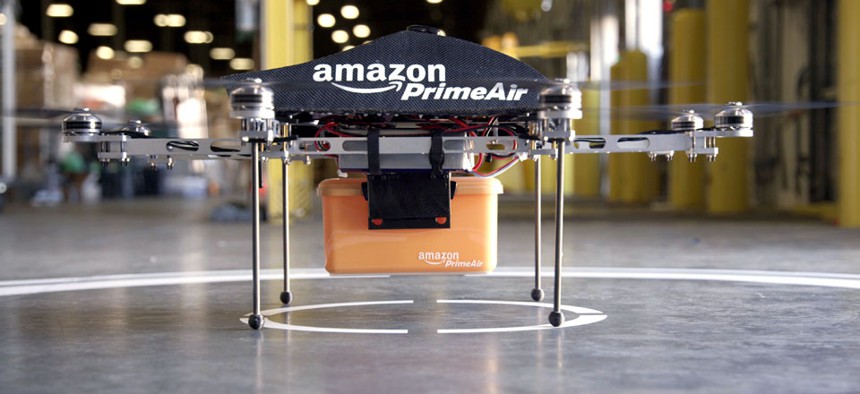Drone-Delivery Expert on Amazon's Plans

The Prime Air unmanned aircraft project that Amazon is working on in its research and development labs. Amazon/AP
"We’re convinced that it’s going to be the next big paradigm in transportation."
Two and a half years ago, Andreas Raptopoulos founded Matternet , a company devoted to creating a network of drones that could deliver lightweight packages. It's starting with medical applications, with plans to extend from there to "bring to the world its next-generation transportation system." To hear Raptopoulostell it, when the histories are written in a few decades, people will think: electric grid, road infrastructure, telephone lines, Internet, mobile phones, and ... tiny flying drones.
"We think about it not just as a point-to-point delivery, but as a network. What can you do if you have many stations of these flying drones?" Raptopoulos said. "What can you do with a system like this in the developing world, in our cities, in our megacities? We’re convinced that it’s going to be the next big paradigm in transportation."
Of course, last night, Amazon's Jeff Bezos revealed Amazon Prime Air , his company's plans to use drones at some point in the future to deliver packages to customers.
It all sounds a little crazy. And we can all think of many objections to drone delivery networks. They won't have enough range! People will shoot them down! What if they crash! They can't operate in places where you can't get a steady GPS signal!
Given that Amazon seems unlikely to give real answers to these questions, I contacted Raptopoulos, who has spent the last several years deeply engaged with these problems since working on a project at Singularity University in 2011 .
First off, why create a network of flying drones at all?
"You have the technology that can help the most difficult part of delivery: The last-mile problem. You have a lightweight package going to a single destination.You cannot aggregate packages. It’s still way too complicated and expensive. It’s very energy inefficient," Raptopoulos said. "UAVs or drones deal with the problem of doing this very efficiently with extremely low cost and high reliability. It’s the best answer to the problem. The ratio of your vehicle to your payload is very low."
Part of the argument is that our current last-mile delivery system can seem kind of ridiculous, at least from an energy efficiency point of view.
As Raptopoulos put it: "In the future, we think it’s going to make more sense to have a bottle of milk delivered to your house from Whole Foods rather than get in your car and drive two tons of metal on a congested road to go get it."
Of course, we could also build walkable neighborhoods that don't require driving as often as we do, but walkability requires density—and even places like San Francisco sometimes balk at the sorts of buildings that entails. And we've got a lot of low-density infrastructure in place that isn't going away anytime soon.
How quickly could this all happen?
Amazon has said their timeline is dependent on rulemaking for civilian drone flights by the Federal Aviation Administration. "We hope the FAA's rules will be in place as early as sometime in 2015," their website contends. "We will be ready at that time."
But even Raptopoulos, a booster of the technology, is skeptical of that timeline.
"It’s not going to happen in the U.S. in the next two or three years. Even if you’re optimistic, it’s not going to happen before three to five years," he said. "Our assumption is that this may happen in other places in the world first. It may happen in the global south in countries that are developing and don’t have alternatives. There, it's not about cost reduction but giving access when you don’t have access at all."
Is this technology anywhere close to ready for mass deployment?
But what about the range of the technology? The batteries aren't good enough, are they?
"We started at 10 kilometers and got to 20 kilometers. Even without assuming a battery breakthrough, we see a 5x increase in the range. If you factor in some advancements to battery development, you might see another 3x increase to 300 kilometers," he contended.
In the near term, Matternet is still trying to get to 100 kilometers by optimizing their system and subsystems. But Raptopoulos is optimistic that it will happen. "There are quadcopters out there that can do 50 kilometers a day, but they cost 10x what our target cost is," he said. "How can you get the technology better while keeping the cost down? Technology is pretty good at that. It’s inevitable it’s going to happen."

But what about reliability?
"We need to design these vehicles to make sure they don’t represent a public risk. If we’re able to do that, we’re ready for primetime," Raptopoulosresponded. "The way to unlock regulatory approval is to show with really good data, 99.9999999—seven nines—percent reliability. Then, of course, you’ll have regulatory approval."
"People saying, 'We’re doing this kind of delivery in China.' Or talking about burritos, pizza, tacos, whatever. All this stuff is BS. In order to get the deliveries working as a system, the drones need to be reliable. Cars are reliable. Planes are reliable."
He continued, "There are three things you're trying to optimize for reliability: time, development, and keeping the cost per vehicle down. The more time and money and cost per vehicle you allow, the better the reliability. For Amazon’s application to make sense, the vehicle cost should be below $20,000. If its $100,000, it’s not cost-effective anymore."
But he saw reliability as far from an insurmountable problem. "It’s the same thing we have with every technology. We know we’ve been able to build much more complex machines. A 777 has thousands of moving parts, versus eight for a quadcopter. But the question is how quickly, for what level of money, for what reliability. These are the competing factors."
But won't you get sued if one crashes?
His company's plan, too, is to start deploying in places where the regulatory and litigation risks are lower. "The application changes your requirement of reliability," Raptopoulos said. "The FAA may require another level than authorities in Haiti. If you lose a vehicle in Palo Alto, you may be sued for millions of dollars. If you lose a vehicle in Haiti, you may not be sued at all. "
But maybe, Raptopoulos contends, there are ways to integrate drones into the airspace that would present a lower risk to everyone. "Maybe there is a way to fly these things on routes where you don’t risk anything where you lose them. It will take that kind of innovation. [To us] it makes sense to start this first in rural places and maybe in the third world. Then once we figure out how to do this at scale, we can bring it here."
What are the specific things that can be done to increase reliability?
"There are a lot of octocopters and a lot of quadcopters, but how do you design one that has the right redundancies? Should the vehicle have a parachute so when it has a catastrophic failure, it doesn’t just fall out of the sky? If you have one failure, can you diagnose and get it to a landing spot?"
Some of those problems may be solved by increasing the sophistication of the analytics they have on each drone. "How well can we predict failures? If we’ve flown 2.5 thousand hours and we have this kind of telemetric data, I might know I should retire the vehicle."
And each environment brings its own challenges."You have to worry about specific problems in specific environments. In Haiti, you have to worry about dust. If you want to work in San Francisco, you have to have worry about GPS signals being lost because of the terrain."
Assuming you can work out the technology, why won't people just shoot them out of the sky?
"They fly at 400 feet between 45-65 kilometers an hour and they are very small. At that height, you can barely see them. You cannot hear them. It’s like a tiny dot moving in the sky. That’s the practical aspect of the question. It’s not going to be a bunch of kids doing it for fun," Raptopoulos said, raining on every kid's parade.
"The second point is that it’s illegal," he said. "The reason we’re not shooting other moving things with guns is because it’s not something that’s legal. It is more challenging to rely on that framework in a place like Haiti or Kenya or Mali. The risk there is higher."
But couldn't the drones get taken out when they land?
"As you pointed out, the vulnerable part of the mission is when they come down," he responded. "In our case, they do a vertical descent and then they go out again. And those locations need to be protected."
Thinking about the developing world contexts where Matternet is working, he continued. "You need to have them owned by people who use the system, and then you tap into the social dynamics. We're not planning to set up the networks in local places. We're just providing the technology. So, they have to be owned by people in the developing world that have the right social status," he said. "It would be people on the ground who understand how their location works. Those people are the experts on the ground. They know how to read the country and protect their assets."
What do you think of the regulatory hurdles in the U.S.?
"We’ve just had a public statement from a big company they want it to happen. Public acceptance goes hand in hand with regulation. There are many reasons that the public will see these as the wave of the future," he said. "But we cannot [make that case] that if we cannot guarantee to the public that this is a safe thing to be flying over our heads and our children."
So, let's say you can fly a few drone deliveries, does this actually work as a big business, the way Amazon seems to be imagining?
"Scale is a challenge in itself. For Amazon to do this, they don’t get to do 10 or 100 deliveries a day, they get to do thousands or hundreds of thousands of deliveries a day. How you resolve the scale issue is a question," Raptopoulos said. "But we’re pretty good at solving those challenges as a technical civilization."
NEXT STORY: We the Ukrainian People



